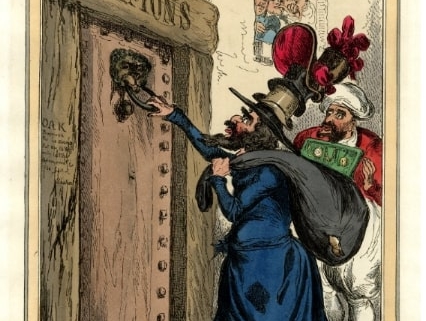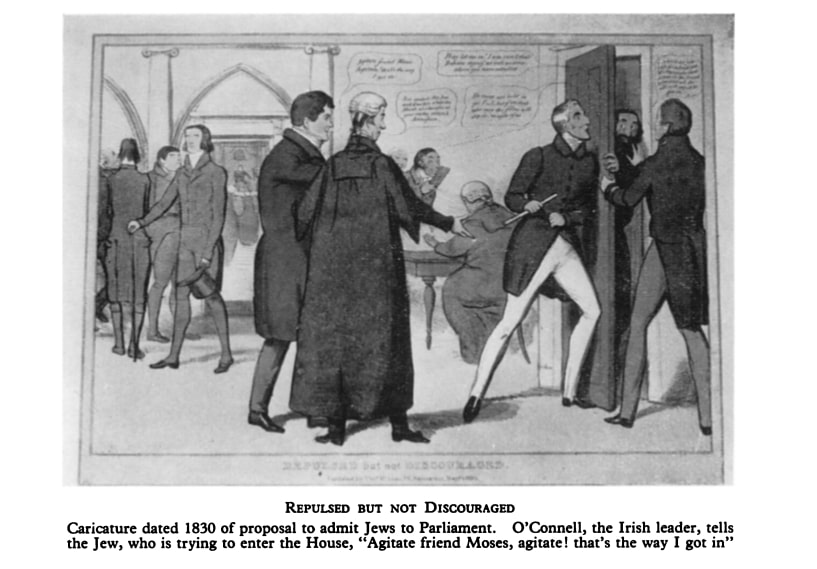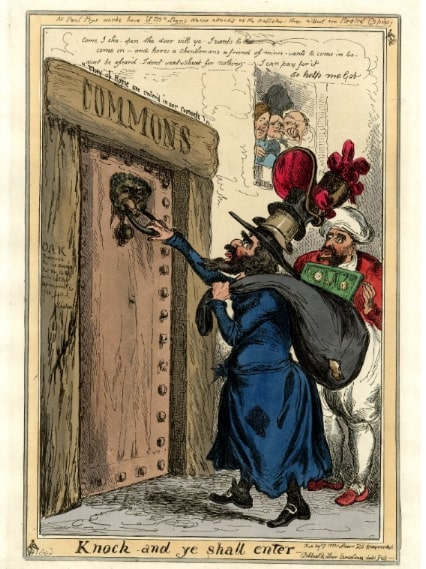Recently, I wrote an article, posted here, on the 1969 Academy-Award-winning film “Midnight Cowboy.” I’m old enough to have seen it in a theater back when it was first released—of course, no DVDs or streaming in those years. I hadn’t seen it again until this year, a gap of a half-century no less. What particularly struck me this time around is how the film was replete with social/cultural messages that I wasn’t consciously aware of back then.
One of the messages or themes, of “Midnight Cowboy” was a negative take on Christianity, which, I realize now, was to be expected coming from the Jewish, gay, and leftist creators of the film. I took note of their identities this time around; I wouldn’t have known to do it back then. Examples:
- The protagonist Joe Buck, Texas-born and raised, now in his twenties, on a bus to New York City, has his transistor radio to his ear listening to a gospel program called “The Sunshine Hour.” “Oh yes, sweet Jesus! I tell you, faith healin’. I got a letter here from a sister enclosing ten dollars.”
Christianity as a money hustle.
- A flashback: Ten-year-old Joe, looking frightened, being baptized, dunked in a river by a tall, lean, rural-looking man, a preacher, in a shirt and tie standing hip deep in the water. People on the shore, their arms raised high in the air, swaying back and forth, lost in Pentecostal rapture. An unsettling image; a bit scary.
Christianity as alien.
- Joe in a shabby apartment in New York City with a stranger named O’Daniel—fifties, short, bald, fleshy, wearing only a loosely tied bathrobe, an odd manner. Leering at Joe, O’Daniel has him turn around so he can get a good look at him, pats Joe’s body.
Out of the blue, O’Daniel says, “Why don’t you and me get right down on our knees right now?” He opens the bathroom door to reveal, attached to the inside of the door, the toilet in view, electric lights flashing, an altar with a statue of Jesus.
Joe bolts for the door to the outside.
“No! Don’t run from Jesus!” implores O’Daniel.
As Joe nears the door, a pole with a sign attached that says “God is love” falls in his way. He frantically thrusts it aside and charges out of the room.
Cut to Joe running down the street as fast as he can go.
Christianity as something to get away from.
- Joe in a hotel room, invited by one Townsend P. Lock, late middle age, in New York, he says, for a paper manufacturer’s convention. Locke had picked Joe up at a carnival shooting gallery.
“What you want?” Joe demands. “What you got me up here for?”
“Oh, Joe, it’s so difficult. . . . Oh, God, I loathe life. I loathe it. Please go. Please.”
“You want me to leave?”
“No, I mean, yes, yes. Please go. Come back tomorrow. Promise? I want to give you a present . . . for your trip. [Joe had told him he was going to Florida.] Please take it.” Locke takes a chain with a Saint Christopher medal off his neck and hands it to Joe. “I want you to have it. You don’t have to be Catholic. Saint Christopher’s the patron saint of all travelers. I want you to have it for helping me be good [refrain from engaging in homosexual sex].”
Joe doesn’t want a useless Saint Christopher medal, especially from someone like this, and gives it back to him.
Christianity as a pointless religion of lesser beings.
“Midnight Cowboy” is associated with the song “Everybody’s Talking” sung by Harry Nilsson—it’s prominent background music in the first scenes and then again in the last ones. It starts out:
Everybody’s talking at me
I don’t hear a word they’re saying
Only the echoes of my mind
Those lyrics certainly didn’t apply to me in my formative years. I heard every word the people talking at me were saying—the Hollywood movies, the network television shows, the popular music, the mass circulation magazines, all of them. I had no critical understanding of what they were saying and its implications for my life, but I heard it and I took it to heart and I lived by it.
Which gets me around to Jim Bakker. This was back in the mid-1970s to the late-‘80s, which is getting to be 35 years ago, so I suppose a lot of people these days know little or nothing about him. He was a very big deal back then. He and his wife Tammy Faye hosted a daily Christian talk show called “The PTL Club,” which was seen widely on a satellite network Jim had created. It was never clear what PTL stood for—Praise The Lord or People That Love, one of the two or both—later on, after Jim and Tammy got in trouble, more on that later, people said it stood for Pass The Loot.
The two of them were diminutive—Jim 5’4’’ and Tammy 4’10’’. Jim decked himself out like his idol Johnny Carson and Tammy piled on the makeup and did some business with her eyebrows and eyelashes and teased her hair to the max.
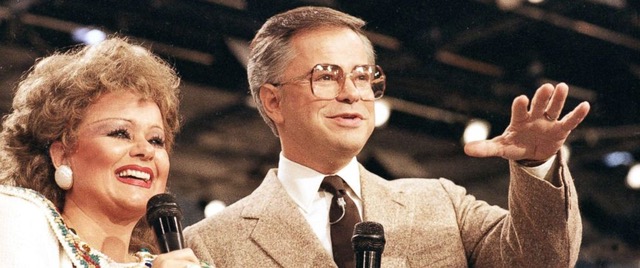
To give a sense of the success of PTL, within four years, more people watched it than tuned in to Johnny Carson’s “Tonight Show.” It was America’s most viewed daily television program. I watched the Jim and Tammy show regularly; or sort of watched it, in the same way I sort of watched “Midnight Cowboy.” It wasn’t that I was religious and watched Jim and Tammy to hear God’s Holy Word. I had been baptized an Episcopalian, my immigrant English mother’s nominal denomination, but I’d had no contact with organized religion growing up or as an adult. For me, watching Jim and Tammy, or going to see “Midnight Cowboy,” was like what George Mallory said back in 1923 about climbing Mount Everest, I did it because it was there.
Jim was originally from Michigan and Tammy grew up in northern Minnesota. Both had modest upbringings. They met in a bible college in Minneapolis and married and quit school to try to make their mark as traveling evangelists. Their first television show was a kids’ puppet show.
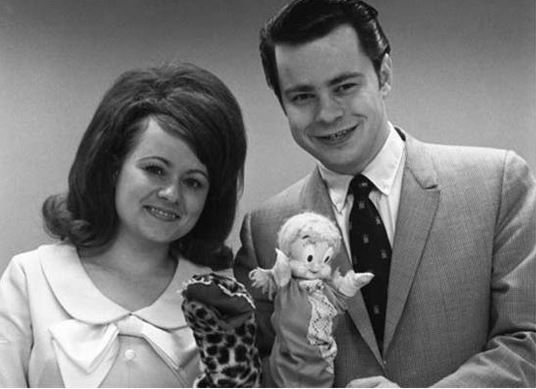
“The PTL Club” began in a Charlotte, North Carolina furniture store. It ran from 1974 to 1989. In addition to putting together the satellite television network, Jim set up a headquarters for his and Tammy’s ministry in North Carolina he called Heritage Village, and he started up a Christian theme park just over the border in South Carolina he called Heritage USA. A good amount of the time on PTL was given over to soliciting viewer contributions to expand Heritage USA. It’s estimated that Jim’s donation pitches resulted in up to two million dollars a week coming in. In time, Heritage USA became the third largest theme park by attendance in the U.S., behind only Disney World in Florida and Disneyland in California. What have you done lately?
Being in the know as I was back then because I had heard the people talking at me—how else would I have known, I hadn’t experienced anything first hand—I knew for a fact that Christians, particularly fundamentalists, were on the wrong side of the heroes/villains divide in life’s drama, and that all televangelists were phonies, hypocrites, and con artists. It came as no surprise to me when Jim got caught in a sexual dalliance in a Florida hotel room a 21-year-old church secretary (not Jim’s) named Jessica Hahn. Jim’s people doled out thousands of dollars in hush money to Jessica, but that didn’t do the trick, if you’ll pardon the expression—Jim’s transgression became front page news. Tammy, who was dealing with a bad prescription pill problem at the time, was devastated by Jim’s betrayal and the humiliating notoriety.
Just as I knew would happen, the Bakkers got caught with their fingers in the till. Jim (Tammy got off clean) was charged with the misuse of ministry funds to finance his and Tammy’s lavish personal lifestyle. The media went after him with a vengeance. After a highly publicized trial—again, front page—Jim was sentenced in 1989 to 45 years in federal prison. This picture after the verdict—which became the iconic photo of him–was used to mock him and get it across that the SOB got what was coming to him. I was fully on board: what a despicable loser. I can’t think of an American in my lifetime who was as universally reviled as Jim Bakker.
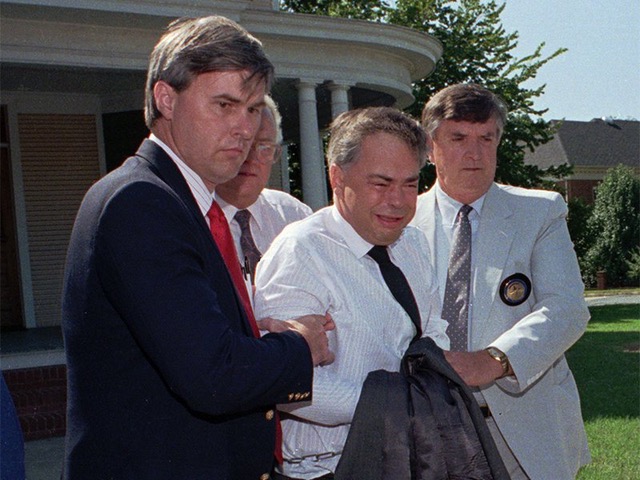
As it turned out, he got out after five years, in December of 1994.
Jump forward to 2009. I’m writing an article called “Message in the Inbox”—it’s on my website, www.robertsgriffin.com—which includes this:
History moves fast, so for those who don’t know about the infamous Jim Bakker—his wife, Tammy Faye, who recently died, got off clean—he was a television evangelist who got jail time for having his hand in the till. Jim and Tammy Faye would emote that their Heritage USA religious theme park would have to be abandoned if the viewers didn’t send them heaps of cash right away. In would come the money and Jim would throw a few bucks at the park and pocket the rest.
The truth of the matter was that I didn’t know what I was talking about in that paragraph, even though I was sure that I did (there’s no delusion like self-delusion). I had glanced through a few newspaper articles and watched some television segments, that was it. What I knew about the Bakkers, as my mother used to phrase it, you could put in your eye. I got my basic angle from my sources, “Midnight Cowboy” and all the rest of the mediators of reality—that’s why they’re called the media—who had been talking at me.
Nobody has ever questioned what I wrote about the Bakkers, because the same people that had been talking at me had been talking at them and so it rang true. If I had been so bold, however, as to defend the Bakkers in that 2009 piece—which, as you can surmise, I’m tooling up to do here—I would have been questioned big time and given a bad rating. As writers of articles, along with stand-up comics and university professors, know well, the best way to go over with people is to confirm what they already believe.
It’s not just Jews, gays, and leftists that have it in for Christianity. I’ve written a couple of articles this past year for this publication that run up against this idea.
“William Pierce and Cosmotheism” was posted in February of 2018. Pierce, who died in 2002, was a prominent white racial advocate. I wrote a book about him—The Fame of a Dead Man’s Deeds (FirstBooks Library, 2001). In the 2018 Cosmotheism article, I outlined Pierce’s criticisms of Christianity in light of his racial commitments. He argued that Christianity’s egalitarianism, universalism, other-worldliness (which distracts whites from attending to their compelling racial business here on earth in this life), and “superstition and craziness” were detrimental to white racial advancement.
The second article, posted in October of 2018, was on William Gayley Simpson (1892–1991), a white nationalist, and entitled “William Gayley Simpson on Christianity and the West.” It included this quote from my book on Dr. Pierce which was taken from Simpson’s book, Which Way Western Man?
In Which Way Western Man? Simpson informs the reader that in his twenties he had read about the life of Francis of Assisi and found it an inspiration and personal challenge. In Simpson’s eyes, St. Francis exemplified what Jesus meant for his most dedicated followers to do in the world. At 28 years of age, during a month alone on an island in the St. Lawrence River, Simpson made the decision to incorporate this ideal into his own life.
Simpson lived a Franciscan life for nine years. Centering his efforts in large cities, he made his way across the American continent trying to better the circumstance of people who were having a tough go of it in life. He toiled as a common laborer, giving his work as a gift and living on whatever others chose to give him in return. It proved to be an experience that was not only a test of what Simpson was made of as a person but also a test of the very foundations that had heretofore directed his life: liberalism, idealism, and Christianity.
Simpson ended this phase of his life when he reached the conclusion that the way he had been conducting himself for nearly a decade was neither the best way for him to serve others nor consistent with his own personal makeup. As laudable as it seemed on the face of it, he decided, what he had been doing hadn’t gotten at the heart of what was wrong with mankind, because it isn’t so much the conditions of human beings that need improvement but rather their caliber, and the way he had gone about things hadn’t gotten at that.
Simpson had tried to become equal to the lowest and the least of individuals, and that just wasn’t him, that wasn’t his path in life, it wasn’t his way forward. It became clear to him that he wanted to affirm the life of the mind and connect with the aristocratic instinct and taste that he felt strongly was natural to him.
Simpson gave over the rest of his life to pointing the way to a finer human existence with particular reference to those he increasingly came to see as his people, whites of northern European background. For them especially, he described a life of health, robustness, beauty, nobility, and meaning far beyond what they were currently seeking and achieving and far more in keeping with what he considered their true nature and possibilities.
It’s now October of 2019 as I write this. Well into retirement as I am and sitting here on this leather couch pretty much from dawn to bedtime, with the last big event in my life coming right up, I’m finding myself drawn to giving energy (such that I still possess) to making sense of what I did with my life and why. I’m learning that a review of my biopic movie, as it were, complete with how many stars I think it merits, is a central feature of old age. There’s much on the line in this endeavor, because we only get to make one movie; no opportunity for re-shoots or sequels. The “Midnight Cowboy” investigations and reflections came out of this “movie review” impulse, as was the decision I made a few weeks ago to look into what went on with Jim and Tammy Faye Bakker.
With the Bakkers, I started with a book by John Wigger, who is a history professor at the University of Missouri, entitled PTL; The Rise and Fall of Jim and Tammy Bakker’s Evangelical Empire (Oxford University Press, 2017). I went from there to a memoir Jim wrote just after he got out of prison called I Was Wrong: The Untold Story of the Shocking Journey from PTL’s Power to Prison and Beyond (Thomas Nelson, 1997). Then it was Jim’s book written with the help of Ken Abraham, The Refuge: A Look into the Future and the Power of Living in a Christian Community (Thomas Nelson, 2000). I read James A. Albert’s book on the 1989 trial, Jim Bakker: Miscarriage of Justice? (Open Court, 1999). Albert is a law professor at Drake University. And I read articles. All of them totally trashed Jim (Tammy does better); not one positive word about him, zero.
Somewhere in all of that, I watched a 2000 documentary called “The Eyes of Tammy Faye” which was sympathetic to her. The blurb for it:
Twelve years after the scandalous collapse of the multimillion-dollar Christian empire built by Jim and Tammy Faye Bakker, “The Eyes of Tammy Faye” tells the fascinating inside story of the rise, fall and resurrection of “the Queen of the Eyelashes.” One of the most adored and reviled women of her time, the film follows her amazing tale from her love at first sight encounter with Jim, through the glory days of PTL, to the scandal that brought both their empire and their family tumbling down.
In the documentary, Tammy reads from Psalm 91.
He shall cover thee with His feathers,
and under His wings shall thou trust.
Because He has set His love upon me,
Therefore I will deliver Him.
I will set Him on high,
because He hath known my name.
He shall call upon me,
and I will answer Him.
I will be with Him in trouble.
I will deliver and honor Him.
And with long life I will satisfy Him,
and show Him my salvation.
Jim and Tammy divorced in 1992 while Jim was in prison. Tammy re-married and died of cancer in 2007. Jim, now bearing in on eighty—white hair, such as there is left of it, close-clipped beard, looking fit—with his second wife Lori does a television show out of Missouri that gets minimal attention. I know nothing about the new show or what Jim is up to generally these days; my focus is on what happened during the PTL and prison years.
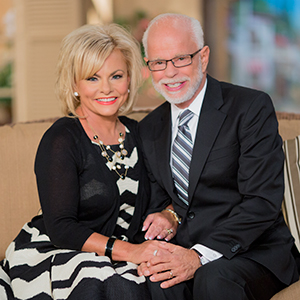
Jim Bakker with his second wife Lori
I’ll be darned, I didn’t expect it, after reading a fair amount on Jim and Tammy, I’ve come to the conclusion that both of them were for real, that they did very good work, and that arguably Jim was innocent of the charges that sent him to prison. I feel awful about the dumb, heartless, and cruel depiction of them I mindlessly tossed off in that article I wrote.
I’ve watched some old YouTubes of PTL as part of my little research project, and this time I picked up on the way Jim ended all of his shows. He looked into the camera and said, “God loves you . . . He really does.” Maybe I’m losing it in my advanced state of geriatricness, but all I can do is report that I don’t think it was a con. I think he really believed it, really meant it. Plus, I’ve decided that in getting across to millions of people that they are loved, as he did so effectively, Jim made an enormous positive contribution to people’s lives. To many, many people, hearing from Jim Bakker that they were loved was the only time in their lives they heard that, and it meant the world to them.
Jim Bakker was able to communicate to millions of people who felt alone, discarded by the world, and that they were nobodies and nothing, that God values them and that they belong, to the Christian community. I’m reminded of the advice the novelist Kurt Vonnegut gave to people who feel cut off and isolated: go to your local church next Sunday morning. Jim getting across to people that they count and are connected to something immensely significant and worthy was a great gift to a whole lot of people.
Jim was ridiculed for calling his Heritage USA donors “partners”—so it went, that was his ploy to shake money loose from them. Here I go again, I think he was sincere; it wasn’t a ploy. For a $1,000 donation, people felt they had a stake in something where otherwise, for many of them, they didn’t have a stake in anything. They and their family were entitled to free lodging for four days at a Heritage USA hotel every year for the rest of their lives. Despite what the media implied at the time, thousands upon thousands of people took advantage of that option; and even if they didn’t, just knowing that they could have done it gave them the feeling of being involved in an endeavor they believed in. Plus, they had the uplifting knowledge that there was a place for them and their children to go where there would be other Christian people like them. Jim set that up and it lasted for fifteen years; quite an accomplishment for someone who started from nothing.
In Jim’s book I Was Wrong, he gets into his personal failings. The Jessica Hahn business got a lot of space. He makes it clear that he now realizes that the prosperity gospel he bought into in a big way got out of hand. He describes getting financially over-extended with the theme park, but he denies siphoning off money designated for it as I had him doing in the 2009 article. He acknowledges that he and Tammy got ostentatious in their personal lives. A board set Jim’s and Tammy’s salaries, which rose to around $1M Jim/$300K Tammy yearly. He describes studying the Bible intensely in prison and coming to realize that the prosperity gospel was inconsistent with the teachings of Jesus. His book The Refuge reflects the changes in his religious orientation from the PTL days.
It came through to me in Jim’s memoir, and from the Wigger book as well, that he was a decent, honest, well-intended person, sincere in his religious beliefs and projects, and a remarkably hard and productive worker. A literacy program for inmates he and another inmate put together when he was in prison particularly impressed me. As I read through his memoir, to my surprise, I grew to like him and, yes, admire him. From everything I have been able to pick up about Jim Bakker, he was no fraud, and yet that is precisely the consensus wisdom about him.
Jim ends I Was Wrong with a description of preaching for the first time after being released from prison.
“I’m scared to death and I’m going to tell you that. This is my first time in the pulpit in many, many, many years.”
“We love you, Jim!” someone shouted.
When I looked around the room and saw so many friends who were still serving God after surviving all that had happened at PTL, I was reminded afresh of God’s promise, “I will never leave you or forsake you.”
The faith of many in this room had been severely tried, and they had come through the refining fire as pure gold. They had not gotten bitter; they had become more loving, more kind, more Christ-like. PTL was not a group of buildings; it was the people of God, in whom God was working. They truly were the People That Love, the people who, no matter what, have continued to Praise The Lord,
Slowly and with deep emotion, I began to read the Twenty-third Psalm: “The Lord in my shepherd; I shall not want. . . . Yea, though I walk through the valley of the shadow of death, I will fear no evil. . . . Thou prepares a table for me in the presence of mine enemies.”
I once thought God had abandoned me. I thought my days of ministering for the Lord were done. I thought that I would never preach again.
I was wrong.
And so too was I wrong—about you, Jim. My apologies.
Looking into the lives of Jim and Tammy Bakker surfaced and underscored some rules to live by, call them that.
- Listen carefully to what people have to say, but don’t just take it in. Question it, work with it, compare it to what others are saying, come to your own conclusions about whatever it is. Don’t uncritically buy into somebody’s narrative and run with it, plugging everything and everybody into that particular story. Look straight at reality: discern what each particular circumstance, event, and human action really is about rather than simply going by what your assumptions and generalizations and authoritative sources say it is. Create your own narratives. That’s what I tried to do with “Midnight Cowboy,” and that’s what I’m trying to it here with the Bakkers.
- Keep in mind that intellectual autonomy and integrity takes courage. Sometimes your truth won’t play well with your audience, but put it out there anyway. You’ll take hits, but you’ll feel good about yourself, and at the end of your life, you won’t be living with the painful conclusion that you sold out in your one shot at life on this earth. Develop your integrity and courage the same way you develop anything else, by practicing. The next chance you get, do the honest and courageous thing.
- Because something is true doesn’t mean it’s everything; there can be other important truths that need to be taken into account too. William Pierce contributed insightful observations about how Christianity can be problematic to whites’ wellbeing and advancement. But there’s also what he didn’t talk about: how Christianity can give peace, joy, meaning, direction, strength, and impetus to one’s life. I offer the list in this last sentence not as insider who has experienced those things but rather as an outsider who hasn’t experienced them and wishes that he had. In any case, we need to ask ourselves with respect to anything, what else is there that matters besides this? What’s all of it?
- Because something is right for one person doesn’t mean it’s right for some other person. To his credit, William Gayley Simpson was speaking only for himself when he said he wanted to affirm a life of the mind and connect with the aristocratic instinct and taste he felt natural to him. I’m sure he would have agreed that this approach might not work for, say, those who dropped out of school after trying and trying and failing and failing, and who take any job they can get and struggle to pay the minimal amount due on the credit card and then get laid off, and who are drinking or taking drugs more than they should and aren’t there for the people that need them as much as they ought to be. Christianity may be a way for these people to feel their lives have meaning and worth, and it could give them the strength to get it together and be better for themselves and for the people in their lives.
- Last, assume your adversaries know what they are doing. People who have it in for white people also tend to be the most bent on pulling the props from under the Christian religion. As brilliant a man as William Pierce was, and I know from personal experience he was brilliant, I’m coming to the conclusion that his opponents know better than he did the positive role Christianity plays in the wellbeing and fate of the white race.
I have a 15-year-old daughter, a sophomore in high school, who lives with her mother in another state from where I live. This week, I sent her a gift of a CD by a Christian singer named Lauren Daigle, “Look Up Child.” I feel good about doing it, and I wouldn’t have thought to do it if I hadn’t looked into the life of Jim Bakker and come to the conclusions I did. Thank you, Jim.
I included a note to Dee, as I’ll call her here, with the CD. Here’s what I said:
Dear Dee—
This is a CD by Lauren Daigle, who sings Christian music. The song “You Say” on this album has been a surprise hit—you can check out the video for it online. Also, check out the video for “Rescue.” You will pick up that Lauren is very different from rap artists or Billie Eilish [Dee recently went to a concert of hers].
75%—three of every four people—in the United States identify themselves as Christians, but how often in school are you encouraged to study them and their way of life, their culture? You should learn about Christian people, and from a position of respect; often, schools and the media put them down as “uncool” and somehow bad.
Christians believe that God exists and loves them and looks out for them.
In these lyrics from “You Say,” the “You” being referred to is God.
You say I am loved when I can’t feel a thing
You say I am strong when I think I am weak
And you say I am held when I am falling short
And when I don’t belong, oh You say I am Yours
And I believe
Oh I believe
What You say of me
I believe
In these “Rescue” lyrics, the “I” who will find you and rescue you is God.
I will send out an army to find you
In the middle of the darkest night
It’s true, I will rescue you
I will never stop marching to reach you
In the middle of the hardest fight
It’s true, I will rescue you
See if you can do a report on Christians in one of your classes—what they believe and how they live. Let me know what you learn.
Love always,
Daddy
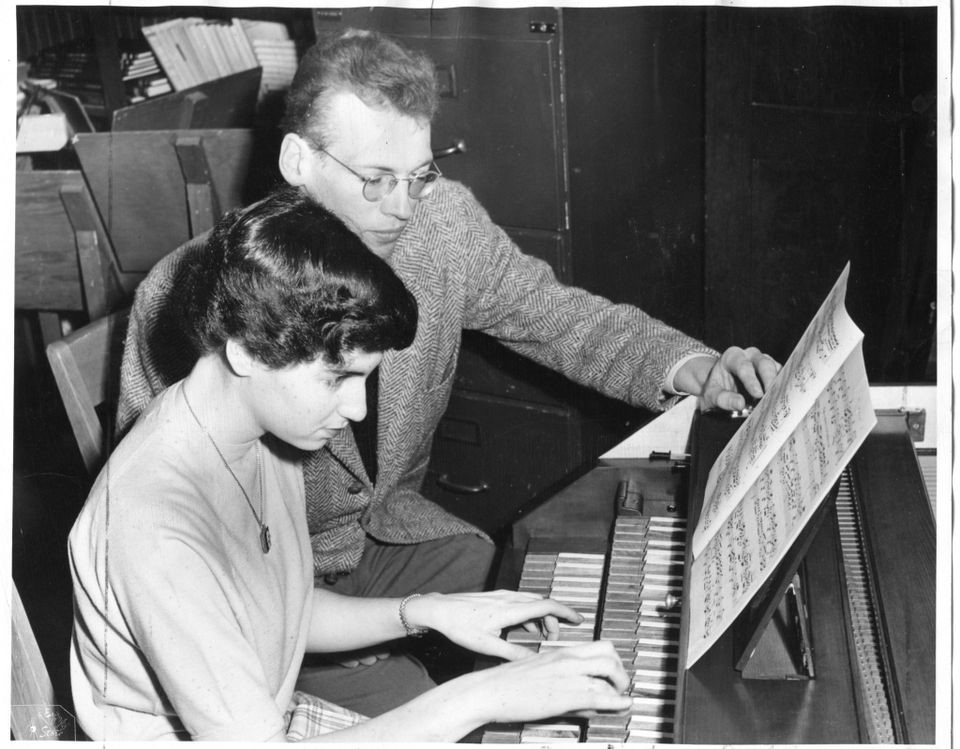

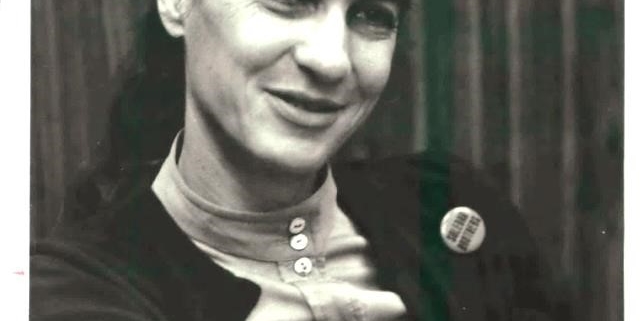
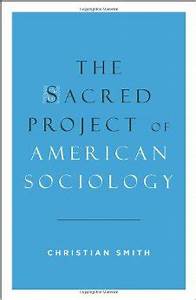
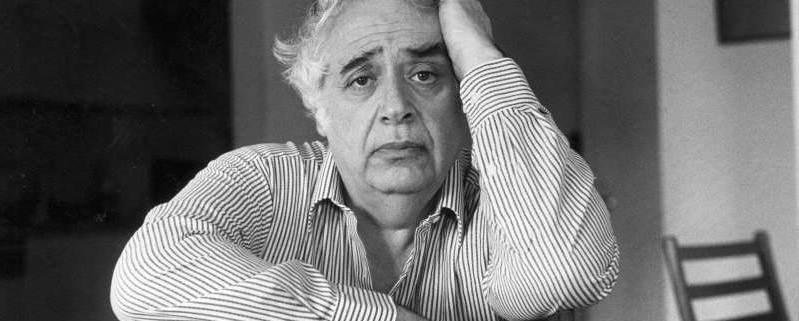








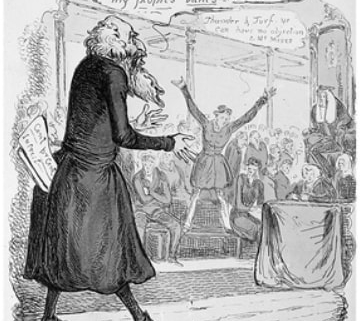
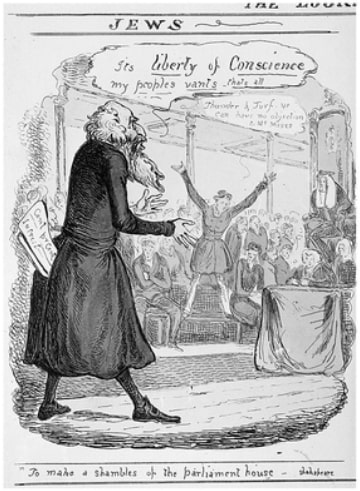 Part IV: The Collapse of the Anti-Jewish Party, 1847–1858
Part IV: The Collapse of the Anti-Jewish Party, 1847–1858
